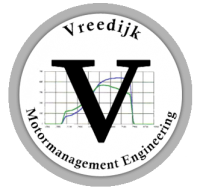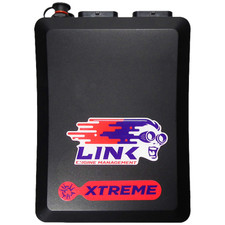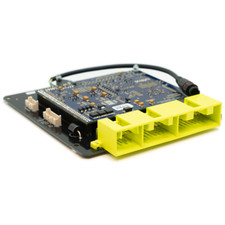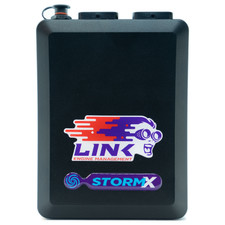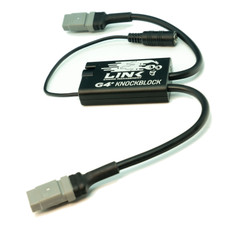Beschrijving
G4+ XTREME ECU
The Xtreme is one of Link’s premium ECU’s with more inputs, outputs and features.
The Xtreme has Peak and Hold Injection, built in E-throttle and all the advanced features including Anti-lag, Cruise Control and Traction Control
With 8 Peak and Hold Injector drives and 8 ignition drives the Xtreme can control up to 4 rotors or 8 cylinders with sequential injection and direct spark. The Xtreme is a great choice for professional level motorsport or more demanding road car applications.
Requires “A” & “B” Looms.
If it is Onboard Digital Wideband Lambda Control you are after, consider the Fury.
(G4+ Xtreme Black ECU | Link Engine Management)
SPEC OVERVIEW:
Inputs
8/10* x Digital inputs
4 x Temperature inputs
11 x Analog inputs
2 x Trigger inputs
2 x Knock inputs
*2 inputs required when using 2nd CAN Bus
Outputs
8 x Peak and Hold injection drives
8 x Ignition drivers
10 x Auxiliary outputs^
+5V Sensor power supply
+8V Sensor power supply
^unused fuel and ignition drives can be used as additional Aux outputs
Communications
2* x CAN bus
1x Serial (RS232) connection
1x USB tuning connection
Physical
Dimensions: 185mm(L) x 130mm(W) x 40mm(H) (without looms)
Mass: 680grams
Advanced features not found on the Storm:
8 Peak and Hold injection drives, user definable current, 10 amp peak, 3 amp hold max.
Fully programmable E-throttle control complete with capability of gear shift throttle blip and antilag.
Cruise control.
Two independent CAN modules.
30 general purpose tables (up from 20)
All Motorsport features including full gear shift control, cruise control, traction control, antilag and launch control.
Advanced closed loop lambda strategy and dual bank lambda control.
What’s in the box?
Supplied with USB tuning cable and mounting bracket.
Requires “A” & “B” looms or “A” & “B” connector kits.
- Four stroke, two stroke, and rotary engines supported
- Engines up to 12 cylinders supported
- Rotary engines up to 4 rotors supported
- All ECUs have on-board barometric compensation
Fuel
- Three fuel equation modes:
- Traditional mode for quicker and simpler tuning setup
- Modelled mode, more complex, but delivers superior results
- Modelled – Multi Fuel, like Modelled mode but provides accurate fueling regardless of fuel blend. Often used for system running petrol-ethanol
- Support for group, sequential, group-staged, and sequential-staged injection configurations
- Accurate modelling and adjustment of fuelling based on:
- Intake manifold pressure
- Throttle position
- Engine size
- Fuel pressure
- Fuel temperature
- Elevation
- Fuel density
- Current blended fuel stoichiometric ratio
- Fuel charge cooling
- Engine coolant temperature
- Intake air temperature
- Charge temperature estimation
- Injector flow rate
- Support for high impedance (saturated) and low impedance (peak and hold) injectors
- 2D or 3D injector dead-time table with configurable axis
- Injector short pulse width adder table for areas of non-linear injector flow
- Advanced injector testing function that allows for control over total number of pulses, rate of pulses, and pulse length
- Four cold start stages based on engine speed, fuel blend, and engine coolant temperature. Auto adjusts cold start settings based on current fuel blend
- Optional 4D and 5D overlay tables with adjustable axis to allow more complex fueling arrangements to be setup
- Switchable dual fuel tables to allow different fueling for different situations
- Acceleration enrichment for when the engine is increasing in speed, with control based upon throttle position or intake manifold pressure
- Configurable overrun fuel cut function for reducing emissions, improving fuel economy, and reducing chance of backfires
- Close Loop Lambda compensation with lockouts for engine coolant temperature, throttle position, throttle position acceleration, start-up timer, and intake manifold pressure. Tuner is also able to configure the maximum trim the closed loop lambda is allowed to apply. Able to use two oxygen sensors to control closed loop lambda for banks on V and boxer engines. Capable of using narrow-band or wide-band oxygen sensors
- Individual cylinder fuel trims are able to be applied to the engine, with the trim being a constant fixed value, or each cylinder able to have a 3D table with configurable axis from which the trim is selected
- Set the injector timing anywhere within the engine cycle. Choose to use a single fixed value, or use a value selected from a 3D table with configurable axis. The injector timing can be configured to be the start, center, or end of the injection pulse
- Staged injection which is fully configurable including minimum pulse width lockout and activation engine speed. Injector dead-time table and short pulse width adder table configurable for staged injectors
- Auxiliary injection that can be used as a third stage of injection with each auxiliary injector able to have an individual 3D control table. Capable of being configured by duty cycle or millisecond units
Ignition
- Support for seven types of ignition system:
- Distributor
- Twin distributors
- Wasted spark
- Direct spark
- Rotary engine – leading wasted spark
- Rotary engine – leading direct spark
- Odd fire wasted spark
- Set the spark edge to be falling or rising
- Millisecond and duty cycle ignition coil dwell modes. 2D or 3D dwell table with configurable axis from which the dwell value is selected
- Adjustable ignition delay compensation
- Configurable spark duration
- Maximum Advance setting to restrict the maximum amount of advance the ECU will apply if setup incorrectly. Used to help prevent engine damage occurring from over advanced ignition angle. Maximum angle is configurable by tuner
- Ignition test function that is capable of activating individual ignition coils for testing or wiring and ignition components
- Idle ignition control function that allows a different idle ignition angle to be applied depending on how far the current idle is from the target idle. This allows the ECU to have fine control to obtain a stable idle
- Adjustment of ignition angle based upon engine coolant temperature or intake air temperature
- Optional 4D and 5D overlay tables with adjustable axis to allow more complex ignition adjustments to be setup
- Switchable dual ignition tables to allow different ignition angles for different situations
Limits
- RPM limit mode that limits engine speed based upon the engine coolant temperature. The maximum allowed engine speed can be specified for each engine coolant temperature. The ECU controls the engine speed by applying an ignition cut and/or a fuel cut
- MAP limit mode that limits inlet manifold pressure. The maximum allowed inlet manifold pressure can be specified for each engine coolant temperature or engine speed. The ECU controls the inlet manifold pressure by applying an ignition cut and/or a fuel cut. The MAP limit mode also has a second switchable limit table that can be used for a different scenario
- Speed limit mode that limits the vehicle speed. The maximum allowed vehicle speed is configured by the tuner and is able to be switched on or off. Perfect for use as a pit lane or valet speed control. The tuner can choose to use a driven or non-driven wheel speed source. The ECU controls the vehicle speed by applying an ignition cut and/or a fuel cut
- Two general purpose RPM Limit modes, these 3D tables have configurable axis and so can be used for many different purposes. One typical use is to control the maximum engine speed based upon oil pressure. If the oil pressure drops the table can be configured to limit the engine speed or completely shut the engine down. The ECU controls the engine speed by applying an ignition cut and/or a fuel cut
- Each of the above limit modes has the option of using the default limit settings, or the tuner can open the advanced limit settings and have absolute control over how the limit system functions
- Each limit mode has an adjustable limit control range over which the limit is progressively introduced. This allows very smooth limiting to be achieved and is not harsh on the engine
- Each limit mode also has the option of applying a hard limit in case the soft limit is not adequate
- Other limit settings configurable by the tuner include an ignition retard trim, an engine start-up lockout and an activation delay
- Each ECU also has a system voltage limit mode that is used to help protect the vehicles electrical system if the charging system voltage rises above the value set by the tuner. In the event of the system voltage exceeding the level set the ECU will shut down the engine
Auxiliary Outputs
- Three types of auxiliary output channel:
<
- On/OFF type outputs. Examples of use include relays, engines fans, and check engine lights
- Frequency type outputs. Examples of use include idle speed control solenoids, variable valve timing solenoids, and shift lights
- Electronic throttle outputs. Can be used for other functions if not using electronic throttle
- Each auxiliary output can be used for a variety of different functions
- Virtual auxiliary channels which can be used to consider up to three conditions and then switch to be active. The state of the virtual auxiliary channel can then be used to control outputs or other ECU functions
- Timer functions which can be used to add a time condition to the control of an output or other ECU function
- Unused auxiliary fuel and ignition channels can be used for the control of other ECU outputs
- Auxiliary output channels are able to be set to a general purpose output function where up to three conditions can be used to control the output
- Auxiliary output channels are able to be set to a general purpose pulse width modulated (PWM) function where the tuner can setup a 3D table with different duty cycles that are selected by the ECU based upon the current axis axis
- Auxiliary output channels are able to be set to drive either low (ground) or high (+v)
Digital Inputs
- For receiving input signals which are either off or on.
- Two types of digital input channel:
- ON/OFF type signals that do not switch back and forth rapidly. Examples include a brake switch, an air conditioning request, and a transmission neutral/park switch
- Frequency type signals, these are ON/OFF type signals that switch rapidly. Examples include wheel speed signals, variable valve timing cam position signals, and ethanol sensor signals. Frequency type digital input channels are also capable of receiving normal (slower) ON/OFF type signals
- Each digital input channels has an optional pull-up resistor. This allows the digital channel to receive signals that switch to ground or to +v
Analog Inputs
- For receiving input signals that vary in resistance or voltage
- Analog temperature channels that are used for receiving a signal that varies in resistance with temperature. Examples include engine coolant temperature, intake air temperature, and fuel temperature signals. These channels have a selectable internal pull-up resistor that can be used for piggy-back type installations
- Analog volt channels that are used for receiving a signal that varies in voltage from 0 to 5 volts. Examples include throttle position, manifold pressure, and oil pressure signals. These channels can also be used with temperature sensors but require an external pullup resistor to be installed
- Calibration tables to support sensors for which a defined calibration does not already exist. This allows the tuner to enter data and get the sensor working quickly
- Fault settings function that assists in identifying when a sensor or sensor wiring has an open circuit or short circuit occur. Each analog channel has its normal lower and upper voltage levels defined by the tuner, when the ECU measures a voltage outside this range it will use a substitute value entered by the tuner. This allows the engine to continue running until a repair can be done
Trigger Inputs
- For receiving information on engine position
- Support for crankshaft and camshaft position sensors
- Optical, hall, or reluctor type position sensors are able to be used
- Over 80 pre-defined trigger modes for many common engines from around the world
- Three configurable trigger patterns that can be used for unsupported engine types
- Four filter levels to remove interference and noise from the trigger signals
- Trigger arming threshold table where the minimum signal voltage can be defined so that low voltage noise on the trigger signal will be ignored
- Calibration function that assists the user to set the base timing of the engine
Motorsport
- Anti-lag – for reducing turbo lag when stepping off and back onto the throttle. Switched or always on arming system. Lockout conditions based upon engine speed and throttle position. Switchable dual anti-lag tables available for different scenarios. Optional cyclic idle mode
- Launch control – four modes for obtaining the best off the line performance in different scenarios:
- Single Launch RPM – for launch control based on a switch condition, normally clutch switch. Uses a single launch engine speed for more simple setup. Does not require a vehicle speed input
- 2D Launch RPM table – for launch control based on vehicle speed. The ECU adjusts launch engine speed based on the current non-driven wheel speed
- 3D Launch RPM table – the ECU selects the launch engine speed from a 3D table with configurable axis options. This allows the tuner to add an extra dimension of control to the launch engine speed
- Latched Launch RPM – for use in rolling start races
- Gear shift control – to allow for quick gear changes
- Options for starting gear shift control include digital input (clutch switch), gear lever force (sequential gearbox), gear lever force (H pattern gearbox), and gear barrel position sensor
- Options for ending gear shift control include time, digital input, or gear barrel position
- Different settings for type of gear shift: driven up shift, driven down shift, overrun up shift, and overrun down shift
- Gear lever force calibration for calibration of volts to newtons
- Support for throttle blipping by throttle blip solenoid or by electronic throttle
- Lockout conditions for engine speed, throttle position, and driven wheel speed
- Traction Control – controlled tyre slip to improve vehicle safety and driveability
- Lockout conditions for engine speed, throttle position, and non-driven wheel speed
- The tuner is able to specify the amount of tyre slip allowed per gear before traction control activates. The traction control system once activated will control engine torque to maintain the slip specified
- A second switchable traction control table which can be used for different track conditions
Idle Speed Control
- Supports idle speed control by idle solenoid, idle stepper motor, or electronic throttle
- Idle speed control has two modes available:
- Open loop mode in which the ECU sets the position of the the idle control device for a given engine coolant temperature
- Closed loop mode in which the actual idle speed is compared to the target idle speed and the ECU then adjusts the idle control device to correct for the difference between the two
- Able to adjust idle when additional load from engine fans, power steering, or air-conditioning use is detected
- A start-up step table in which the tuner can specify an extra amount of opening by the idle control device during engine starting to help the engine start easier
Electronic Throttle Control
- Support for electronic throttle bodies and foot position sensors
- Uses a 3D electronic throttle target table with configurable axis in which the desired percentage of throttle opening is specified by the tuner
- Capable of having a throttle position that does not match the foot position. Useful for helping maintain traction
- Up to three switchable electronic throttle target tables for different driving conditions. Useful for switching to a more aggressive or gentle throttle response
- Multiple safety condition checks that are continuously carried out to monitor the electronic throttle system for faults. Upon a fault being detected the system restricts the engine speed
Boost Control
- Two boost control modes:
- Open loop mode in which the ECU sets the wastegate solenoid duty cycle based upon the wastegate duty cycle table which the tuner has setup
- Closed loop mode in which the ECU compares the current intake manifold pressure to the boost target table the tuner has setup. The ECU then adjusts the wastegate solenoid duty cycle to correct for the difference between the two
- Engine speed and intake manifold pressure lockout conditions
- Up to three switchable wastegate duty cycle or boost target tables. Allows for multiple levels of boost control, a common use of this would be a street tune table and a race tune table
- An interpolate between mode in which the ECU interpolates between two wastegate duty cycle tables or two boost target tables based upon the current blended fuel mixture. Typically used for petrol/ethanol fuel mixtures
- Trim tables for intake air temperature, engine coolant temperature, and gear
Knock Control
- Knock controls helps protect the engine by retarding the ignition timing to an individual cylinder when engine knock (detonation) is detected in the cylinder
- Uses advanced Digitally Signal Processed (DSP) technology to monitor for engine knock
- Supports narrow-band and wide-band type knock sensors
- Supports single harmonic and dual harmonic type sensors
- ECU able to support up to two knock sensors
- Knock control system is able to detect which cylinder or rotor the engine knock occurred in by using windowing
- Uses a knock target table in which the tuner specifies the threshold above which engine noise is considered engine knock
- Adjust the gain for each cylinder based upon its distance from the knock sensor
- Control the amount of ignition retard applied for the level of engine knock detected
- Specify the delay after engine knock stops before re-introducing ignition timing, and also specify the rate at which the ignition timing is re-introduced
- Lockout conditions based upon engine speed, throttle position, and throttle position rate of change
VVT Control
- Variable valve timing (VVT) control monitors the position of camshafts, compares them to the tuner setup cam target table and then adjusts the camshaft solenoid duty cycle until the actual and target camshaft positions match
- The VVT control has predefined modes for over 40 common engines
- For engines where a predefined VVT mode does not exist there is a user defined mode
- The VVT control has a cam angle test function to assist in VVT setup
- Lockout conditions based on engine speed and engine coolant temperature
- Up to three switchable target tables for intake camshaft control, and the same for exhaust camshaft control
- Optional advanced PID control settings for advanced tuners
Chassis and Body
- Cruise Control – uses the electronic throttle body to achieve and maintain the set vehicle speed.
- Lockouts for minimum vehicle speed, maximum vehicle speed, and maximum acceleration rate
- Cruise control switches can come into the ECU over analog channels, digital input channels, or over a CAN bus
- Gear Detection – support for three different modes of gear detection:
- RPM/Speed mode where the ECU compares the engine speed to the vehicle speed to determine the current gear
- CAN mode, where the current gear comes to the ECU over a CAN bus from the transmission computer
- Analog Position Sensor mode where the ECU monitors the voltage on an analog input channel and knows the gear from the volt/gear information filled in by the tuner
- AC Clutch control – the ECU has two different modes of air conditioning control:
- Basic – for use in systems where an air conditioning controller exists. The ECU receives an air conditioning request from the air conditioning controller, it then engages the air conditioning compressor clutch
- Full – for use in systems where an air conditioning controller does not exist. The ECU receives an air conditioning request from a switch or over CAN, it then checks the system high and low pressure and evaporator temperature, if these are within the limits set by the tuner it engages the air conditioning compressor clutch
- Both air conditioning modes have a configurable lockout based upon throttle position, intake manifold pressure, or injector duty cycle
- Anti Theft – for interfacing with factory or aftermarket alarm and keyless entry systems. When anti theft is active the engine will not start. Capable of accepting input from a digital input or over a CAN bus
- Speed Sources – for configuring the vehicles wheel speed sources. Wheel speeds are able to come into the ECU over digital inputs channels or a CAN bus. Speed sources also includes settings for slip and speed correction
- Starter control – four different modes for starter motor control including:
- Start/Stop where one switch or button is used for starting and stopping the engine
- Touch start where the driver momentarily presses a button or turns the key and the engine keeps cranking until started or a tuner set amount of time is reached
- Transmission – settings for transmission input shaft calibration. The input shaft speed can then be compared to engine speed and the slip is capable of being displayed and logged
Communication
- Up to two CAN modules for communication with factory and aftermarket devices
- Custom CAN configuration allowing tuners and end users to add support for new CAN devices
- Serial connection for tuning of ECU and sending ECU data to aftermarket displays
- USB connection for tuning of ECU
ECU Logging
- Log up to 100 parameters, the tuner can select which parameters to log
- Select the rate each parameter will be logged at from 0.5 to 100 times per second
- Specify the conditions under which ECU logging will be active. Options include a switched input, an engine speed level, a throttle position, an intake manifold pressure or a combination of all and more
- Set how long the ECU will continue logging for once the activation conditions are no longer met
- ECU Logging loops, so once all the internal logging memory is used the ECU logging will start to overwrite the oldest data
PCLink Tuning Software
- Easy to use tool for configuring Link G4+ ECUs
- ECU Settings menu – access all the ECU settings in one location. Use the tree structure, tables list, or search box
- Log File Manager – view, playback, delete, or cut into sections log files recorded from ECU or PC Logging
- PC Logging – a powerful PC based logging tool that is capable of logging all parameters and saving the file to the PC
- Customisable layouts – add a gauge, settings box, table, logging time plot and more to the current view. Multiple tabs for multiple views at the click of a mouse
- Quick Tune – an interactive tuning tool that assists in quick tuning of the fuel table. Quick Tune compares the target lambda reading with the actual lambda reading and then modifies the current fuel table value to correct for any difference
- Runtime values window – access hundreds of live parameters at the press of a button. The parameters are grouped into tabs including fuel, ignition, triggers, limits, analog inputs, digital inputs, auxiliary outputs, VVT, knock control, CAN and more
- PCLink Help – over 850 pages of in depth help relating to ECU wiring, configuration, tuning, and use. Press the F1 key with any setting selected to see specific help on the setting
- Languages – view PCLink and the help file in English or Japanese, with more languages on the way
- View units in metric or imperial display modes, change display modes at the press of a button. Customise a display mode to use a mixture of metric and imperial units if desired
- Trigger scope – a tool that graphically captures the trigger data. Useful for helping diagnose triggering problems. Save the image and email it into technical support for assistance
